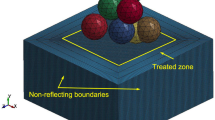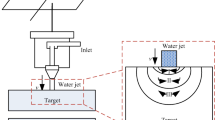Abstract
Abrasive waterjet peening is a promising method for surface strengthening and anti-fatigue processing, which has the advantages such as cleanness, high efficiency and low thermal effect. The surface integrity and fatigue performance of the specimens processed by abrasive waterjet peening are still lack of attention to be paid. In this paper, a numerical model was utilized to study the residual stress distribution and the surface roughness of the Ti–6Al–4V specimen surface in abrasive waterjet peening. The validity of the model were then verified by experiments. Moreover, the fatigue performance of the abrasive waterjet peened specimen were investigated numerically, and the fatigue life tests were also conducted under various loading conditions. The effects of different parameters on the surface integrity and the fatigue property were analyzed. The results indicates that higher residual stress can be obtained by implementing high particle velocity and large particle diameter. The fatigue life of the specimen will be decreased when using larger abrasive particles due to the deteriorated surface roughness.













Similar content being viewed by others
Availability of data and materials
Not applicable.
Code availability
The software used in the present study is authorized.
References
Sadasivam B, Hizal A, Arola D (2009) Abrasive waterjet peening with elastic prestress: a parametric evaluation. Int J Mach Tools Manuf 49:134–141. https://doi.org/10.1016/j.ijmachtools.2008.10.001
Liu M, Zheng Q, Wang X, Xu C (2022) Characterization of distribution of residual stress in shot-peened layer of nickel-based single crystal superalloy DD6 by nanoindentation technique. Mech Mater 164:104143. https://doi.org/10.1016/j.mechmat.2021.104143
Jiang T, Zhou W, Tang J, Zhao X, Zhao J, Liu H (2022) Constitutive modelling of AISI 9310 alloy steel and numerical calculation of residual stress after shot peening. Int J Impact Eng 166:104235. https://doi.org/10.1016/j.ijimpeng.2022.104235
Frija M, Hassine T, Fathallah R, Bouraoui C, Dogui A (2006) Finite element modelling of shot peening process: prediction of the compressive residual stresses, the plastic deformations and the surface integrity. Mater Sci Eng A 426:173–180. https://doi.org/10.1016/j.msea.2006.03.097
Miao HY, Larose S, Perron C, Lévesque M (2009) On the potential applications of a 3D random finite element model for the simulation of shot peening. Adv Eng Softw 40:1023–1038. https://doi.org/10.1016/j.advengsoft.2009.03.013
Dong X, Zhang H, Duan X (2010) Finite element simulation of residual stress field with water jet peening strengthening. Jixie Gongcheng Xuebao/J Mech Eng 46:189–194. https://doi.org/10.3901/JME.2010.18.189
Hsu CY, Liang CC, Teng TL, Nguyen AT (2013) A numerical study on high-speed water jet impact. Ocean Eng 72:98–106. https://doi.org/10.1016/j.oceaneng.2013.06.012
Cho JR (2015) Simulation of the repeated waterdrop impact onto the AL6061-T6. J Mech Sci Technol 29:3679–3683. https://doi.org/10.1007/s12206-015-0812-8
He Z, Cui B, Zhao S, Liu Z, Yu J, Li C, Yu H, Chen L (2021) Numerical simulation of surface topography and residual stress after abrasive water jet sequential peening. Proc Inst Mech Eng Part L J Mater Des Appl 235:777–795. https://doi.org/10.1177/1464420720978513
He Z, Zhao S, Fu T, Chen L, Zhang Y, Zhang M, Wang P (2018) Experimental and numerical analysis of water jet peening on 6061 aluminum alloy. J Press Vessel Technol Trans ASME. https://doi.org/10.1115/1.4039071
Zhang J, Yao C, Tan L, Cui M, Lin Z, Han W, Min X (2021) Shot peening parameters optimization based on residual stress-induced deformation of large fan blades. Thin-Walled Struct 161:107467. https://doi.org/10.1016/j.tws.2021.107467
Ongtrakulkij G, Khantachawana A, Kajornchaiyakul J, Kondoh K (2022) Effects of the secondary shot in the double shot peening process on the residual compressive stress distribution of Ti–6Al–4V. Heliyon 8:e08758. https://doi.org/10.1016/j.heliyon.2022.e08758
Ohta T, Sato Y (2022) Effect of saturation peening on shape and residual stress distribution after peen forming. Int J Adv Manuf Technol 119:4659–4675. https://doi.org/10.1007/s00170-021-08473-6
Wu J, Liu H, Wei P, Lin Q, Zhou S (2020) Effect of shot peening coverage on residual stress and surface roughness of 18CrNiMo7-6 steel. Int J Mech Sci 183:105785. https://doi.org/10.1016/j.ijmecsci.2020.105785
Ghanbari S, Bahr DF (2020) Predictions of decreased surface roughness after shot peening using controlled media dimensions. J Mater Sci Technol 58:120–129. https://doi.org/10.1016/j.jmst.2020.03.075
Bao L, Li K, Zheng J, Zhang Y, Zhan K, Yang Z, Zhao B, Ji V (2022) Surface characteristics and stress corrosion behavior of AA 7075–T6 aluminum alloys after different shot peening processes. Surf Coat Technol 440:128481. https://doi.org/10.1016/j.surfcoat.2022.128481
Liu YG, Li MQ, Liu HJ (2017) Nanostructure and surface roughness in the processed surface layer of Ti–6Al–4V via shot peening. Mater Charact 123:83–90. https://doi.org/10.1016/j.matchar.2016.11.020
Qin Z, Li B, Zhang H, Youani Andre Wilfried T, Gao T, Xue H (2022) Effects of shot peening with different coverage on surface integrity and fatigue crack growth properties of 7B50-T7751 aluminum alloy. Eng Fail Anal 133:106010. https://doi.org/10.1016/j.engfailanal.2021.106010
Soyama H, Chighizola CR, Hill MR (2021) Effect of compressive residual stress introduced by cavitation peening and shot peening on the improvement of fatigue strength of stainless steel. J Mater Process Technol 288:116877. https://doi.org/10.1016/j.jmatprotec.2020.116877
Wang Y, Zhang Y, Song G, Niu W, Xu Z, Huang C (2020) Effect of shot peening on fatigue crack propagation of Ti6Al4V. Mater Today Commun 25:101430. https://doi.org/10.1016/j.mtcomm.2020.101430
Seddik R, Bahloul A, Atig A, Fathallah R (2017) A simple methodology to optimize shot-peening process parameters using finite element simulations. Int J Adv Manuf Technol 90:2345–2361. https://doi.org/10.1007/s00170-016-9532-1
ElTobgy MS, Ng E, Elbestawi MA (2005) Finite element modeling of erosive wear. Int J Mach Tools Manuf 45:1337–1346. https://doi.org/10.1016/j.ijmachtools.2005.01.007
Hlaváč LM (2009) Investigation of the abrasive water jet trajectory curvature inside the kerf. J Mater Process Technol 209:4154–4161. https://doi.org/10.1016/j.jmatprotec.2008.10.009
Arola DD, Mccain ML (2015) Abrasive waterjet peening: A new method of surface preparation for metal orthopedic implants. J Biomed Mater Res Part B Appl Biomater 53:536–546
Taro M, Chaise T, Nélias D (2015) A methodology to predict the roughness of shot peened surfaces. J Mater Process Technol 217:65–76. https://doi.org/10.1016/j.jmatprotec.2014.10.016
Arola D, Williams CL (2002) Estimating the fatigue stress concentration factor of machined surfaces. Int J Fatigue 24:923–930. https://doi.org/10.1016/S0142-1123(02)00012-9
Acknowledgments
This work is supported by Natural Science Foundation of Shandong Province (ZR2020ME154).
Funding
This work is supported by Natural Science Foundation of Shandong Province (ZR2020ME154).
Author information
Authors and Affiliations
Contributions
ZL completed the main work of writing, simulation and experimental works; RH conducted parts of the modeling and analyzing; RW and YZ conducted parts of the experimental works; MZ organized the data of simulations and experiments.
Corresponding author
Ethics declarations
Conflict of interest
Not applicable.
Additional information
Technical Editor: Marcelo Areias Trindade.
Publisher's Note
Springer Nature remains neutral with regard to jurisdictional claims in published maps and institutional affiliations.
Rights and permissions
Springer Nature or its licensor holds exclusive rights to this article under a publishing agreement with the author(s) or other rightsholder(s); author self-archiving of the accepted manuscript version of this article is solely governed by the terms of such publishing agreement and applicable law.
About this article
Cite this article
Lv, Z., Hou, R., Wang, R. et al. Investigation on surface integrity and fatigue performance in abrasive waterjet peening. J Braz. Soc. Mech. Sci. Eng. 44, 520 (2022). https://doi.org/10.1007/s40430-022-03820-4
Received:
Accepted:
Published:
DOI: https://doi.org/10.1007/s40430-022-03820-4




